headrest Hyundai Azera 2010 Owner's Manual
[x] Cancel search | Manufacturer: HYUNDAI, Model Year: 2010, Model line: Azera, Model: Hyundai Azera 2010Pages: 334, PDF Size: 12.24 MB
Page 33 of 334
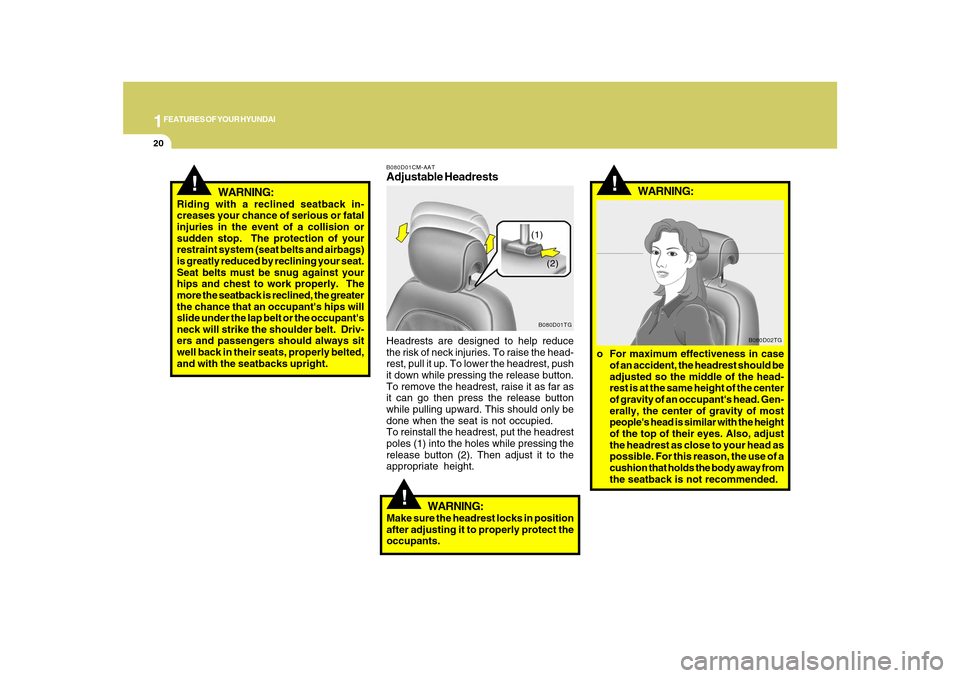
1FEATURES OF YOUR HYUNDAI20
!
WARNING:
Riding with a reclined seatback in-
creases your chance of serious or fatal
injuries in the event of a collision or
sudden stop. The protection of your
restraint system (seat belts and airbags)
is greatly reduced by reclining your seat.
Seat belts must be snug against your
hips and chest to work properly. The
more the seatback is reclined, the greater
the chance that an occupant's hips will
slide under the lap belt or the occupant's
neck will strike the shoulder belt. Driv-
ers and passengers should always sit
well back in their seats, properly belted,
and with the seatbacks upright.
B080D01CM-AATAdjustable HeadrestsHeadrests are designed to help reduce
the risk of neck injuries. To raise the head-
rest, pull it up. To lower the headrest, push
it down while pressing the release button.
To remove the headrest, raise it as far as
it can go then press the release button
while pulling upward. This should only be
done when the seat is not occupied.
To reinstall the headrest, put the headrest
poles (1) into the holes while pressing the
release button (2). Then adjust it to the
appropriate height.
B080D01TG(1)
!
WARNING:
o For maximum effectiveness in case
of an accident, the headrest should be
adjusted so the middle of the head-
rest is at the same height of the center
of gravity of an occupant's head. Gen-
erally, the center of gravity of most
people's head is similar with the height
of the top of their eyes. Also, adjust
the headrest as close to your head as
possible. For this reason, the use of a
cushion that holds the body away from
the seatback is not recommended.
B080D02TG
!
WARNING:
Make sure the headrest locks in position
after adjusting it to properly protect the
occupants.
(2)
Page 34 of 334
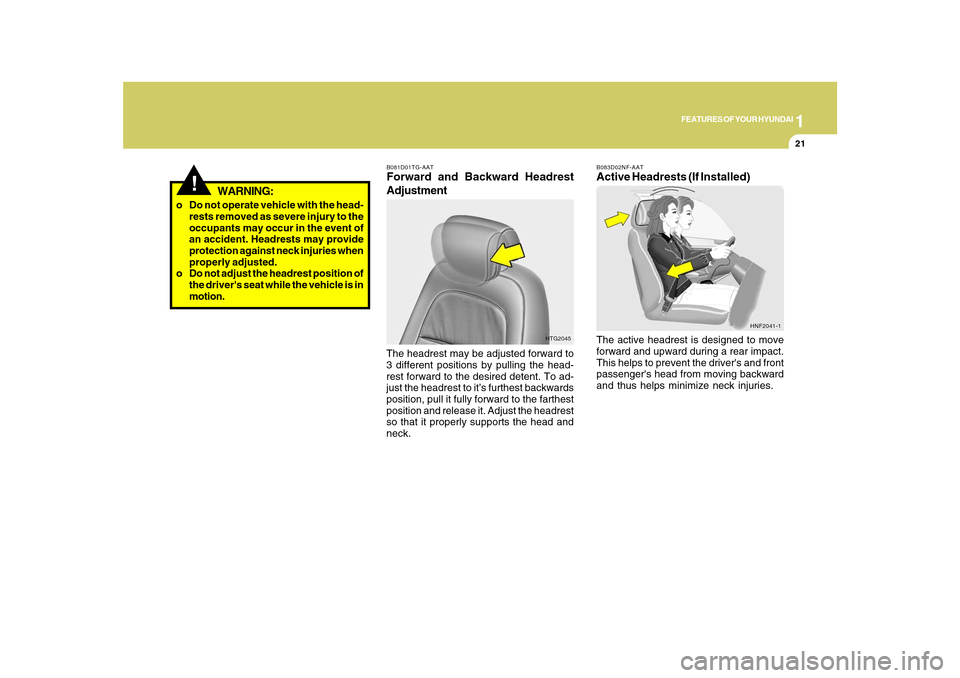
1
FEATURES OF YOUR HYUNDAI
21
!
WARNING:
B081D01TG-AATForward and Backward Headrest
AdjustmentThe headrest may be adjusted forward to
3 different positions by pulling the head-
rest forward to the desired detent. To ad-
just the headrest to it’s furthest backwards
position, pull it fully forward to the farthest
position and release it. Adjust the headrest
so that it properly supports the head and
neck.
HTG2045
B083D02NF-AATActive Headrests (If Installed)The active headrest is designed to move
forward and upward during a rear impact.
This helps to prevent the driver's and front
passenger's head from moving backward
and thus helps minimize neck injuries.
HNF2041-1
o Do not operate vehicle with the head-
rests removed as severe injury to the
occupants may occur in the event of
an accident. Headrests may provide
protection against neck injuries when
properly adjusted.
o Do not adjust the headrest position of
the driver's seat while the vehicle is in
motion.
Page 38 of 334
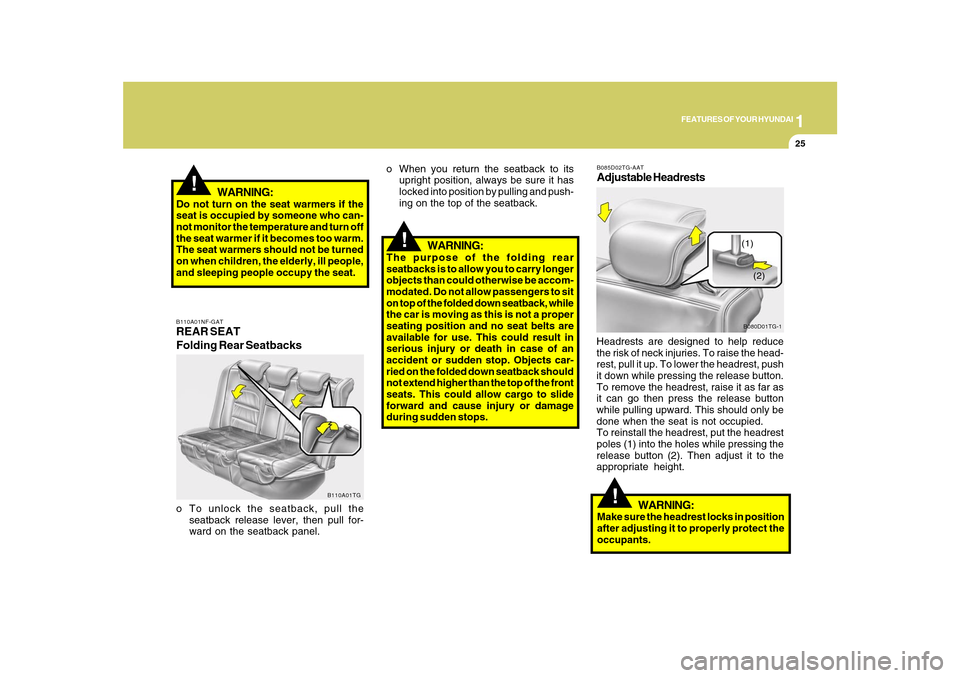
1
FEATURES OF YOUR HYUNDAI
25
B110A01NF-GATREAR SEAT
Folding Rear Seatbackso To unlock the seatback, pull the
seatback release lever, then pull for-
ward on the seatback panel.
B110A01TG
!
WARNING:
Do not turn on the seat warmers if the
seat is occupied by someone who can-
not monitor the temperature and turn off
the seat warmer if it becomes too warm.
The seat warmers should not be turned
on when children, the elderly, ill people,
and sleeping people occupy the seat.
!
WARNING:
The purpose of the folding rear
seatbacks is to allow you to carry longer
objects than could otherwise be accom-
modated. Do not allow passengers to sit
on top of the folded down seatback, while
the car is moving as this is not a proper
seating position and no seat belts are
available for use. This could result in
serious injury or death in case of an
accident or sudden stop. Objects car-
ried on the folded down seatback should
not extend higher than the top of the front
seats. This could allow cargo to slide
forward and cause injury or damage
during sudden stops.
B085D02TG-AATAdjustable HeadrestsHeadrests are designed to help reduce
the risk of neck injuries. To raise the head-
rest, pull it up. To lower the headrest, push
it down while pressing the release button.
To remove the headrest, raise it as far as
it can go then press the release button
while pulling upward. This should only be
done when the seat is not occupied.
To reinstall the headrest, put the headrest
poles (1) into the holes while pressing the
release button (2). Then adjust it to the
appropriate height.
B080D01TG-1(1)
o When you return the seatback to its
upright position, always be sure it has
locked into position by pulling and push-
ing on the top of the seatback.
(2)
!
WARNING:
Make sure the headrest locks in position
after adjusting it to properly protect the
occupants.
Page 39 of 334
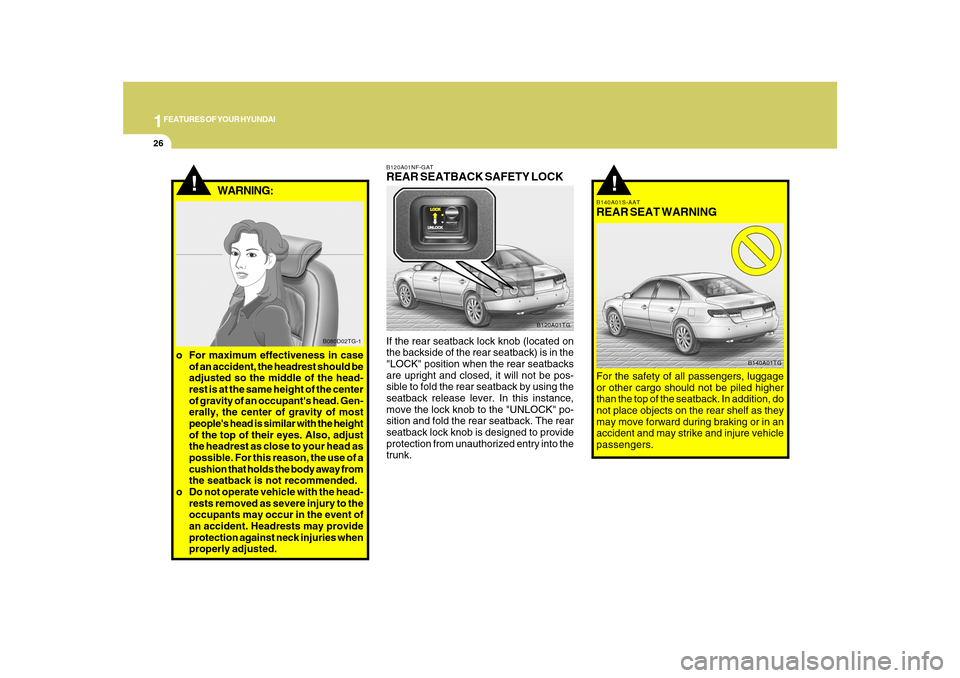
1FEATURES OF YOUR HYUNDAI26
!
B140A01S-AATREAR SEAT WARNINGFor the safety of all passengers, luggage
or other cargo should not be piled higher
than the top of the seatback. In addition, do
not place objects on the rear shelf as they
may move forward during braking or in an
accident and may strike and injure vehicle
passengers.
B140A01TG B120A01NF-GAT
REAR SEATBACK SAFETY LOCKIf the rear seatback lock knob (located on
the backside of the rear seatback) is in the
"LOCK" position when the rear seatbacks
are upright and closed, it will not be pos-
sible to fold the rear seatback by using the
seatback release lever. In this instance,
move the lock knob to the "UNLOCK" po-
sition and fold the rear seatback. The rear
seatback lock knob is designed to provide
protection from unauthorized entry into the
trunk.
B120A01TG
!
WARNING:
B080D02TG-1
o For maximum effectiveness in case
of an accident, the headrest should be
adjusted so the middle of the head-
rest is at the same height of the center
of gravity of an occupant's head. Gen-
erally, the center of gravity of most
people's head is similar with the height
of the top of their eyes. Also, adjust
the headrest as close to your head as
possible. For this reason, the use of a
cushion that holds the body away from
the seatback is not recommended.
o Do not operate vehicle with the head-
rests removed as severe injury to the
occupants may occur in the event of
an accident. Headrests may provide
protection against neck injuries when
properly adjusted.
Page 49 of 334
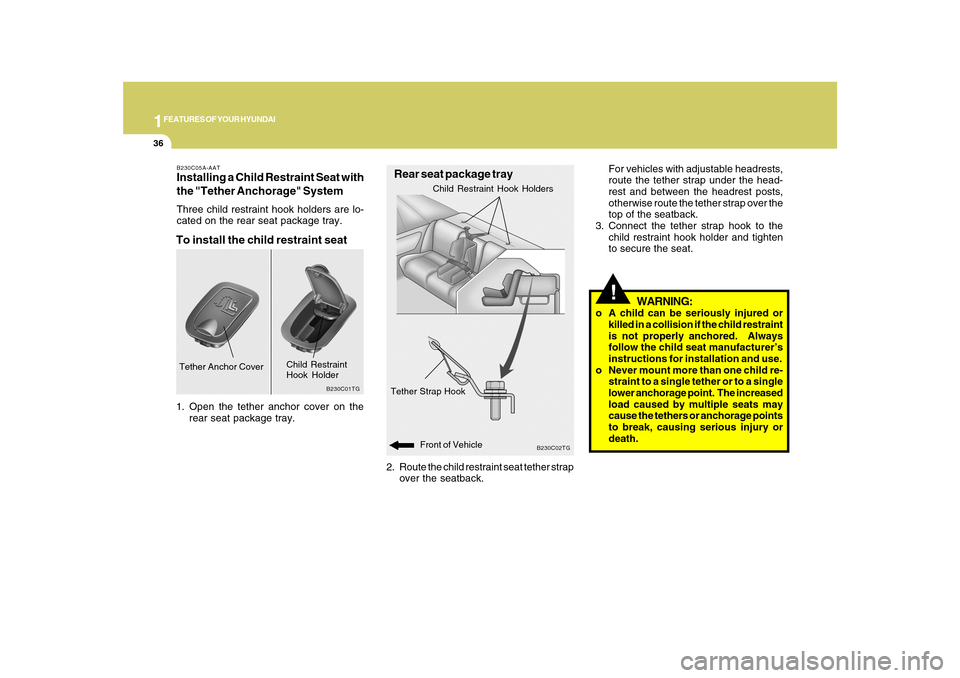
1FEATURES OF YOUR HYUNDAI36
!For vehicles with adjustable headrests,
route the tether strap under the head-
rest and between the headrest posts,
otherwise route the tether strap over the
top of the seatback.
3. Connect the tether strap hook to the
child restraint hook holder and tighten
to secure the seat.
WARNING:
o A child can be seriously injured or
killed in a collision if the child restraint
is not properly anchored. Always
follow the child seat manufacturer’s
instructions for installation and use.
o Never mount more than one child re-
straint to a single tether or to a single
lower anchorage point. The increased
load caused by multiple seats may
cause the tethers or anchorage points
to break, causing serious injury or
death.
2. Route the child restraint seat tether strap
over the seatback.
B230C02TG
Rear seat package trayTether Strap Hook
Child Restraint Hook Holders
B230C05A-AATInstalling a Child Restraint Seat with
the "Tether Anchorage" SystemThree child restraint hook holders are lo-
cated on the rear seat package tray.To install the child restraint seat1. Open the tether anchor cover on the
rear seat package tray.
B230C01TG
Tether Anchor Cover
Child Restraint
Hook Holder
Front of Vehicle
Page 331 of 334
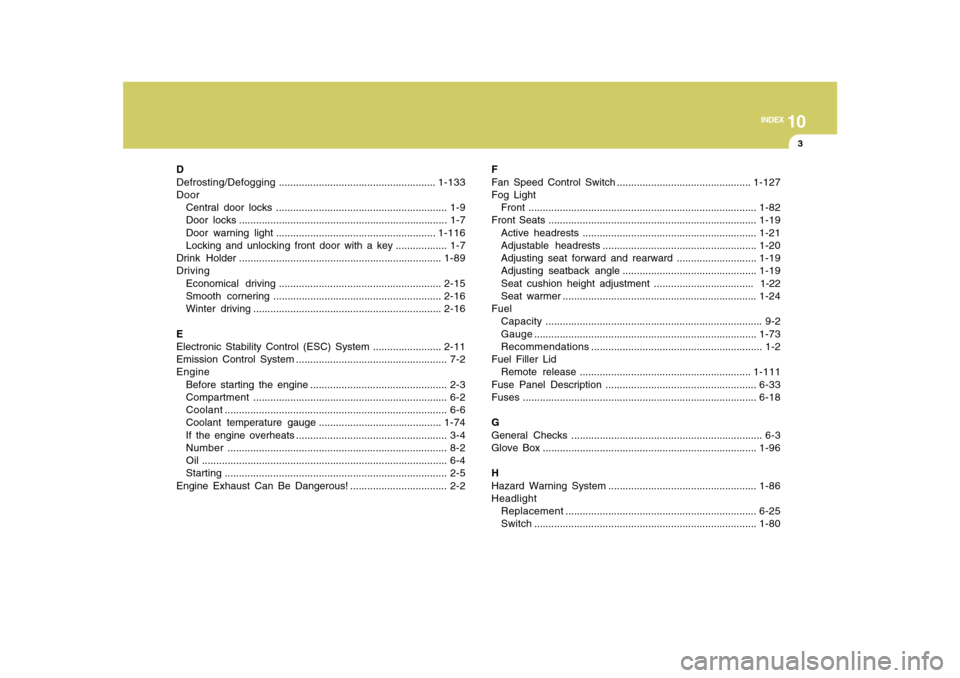
10
INDEX
3
D
Defrosting/Defogging.......................................................1-133
Door
Central door locks ............................................................ 1-9
Door locks ......................................................................... 1-7
Door warning light ........................................................1-116
Locking and unlocking front door with a key .................. 1-7
Drink Holder .......................................................................1-89
Driving
Economical driving .........................................................2-15
Smooth cornering ...........................................................2-16
Winter driving ..................................................................2-16
E
Electronic Stability Control (ESC) System ........................2-11
Emission Control System ..................................................... 7-2
Engine
Before starting the engine ................................................ 2-3
Compartment.................................................................... 6-2
Coolant .............................................................................. 6-6
Coolant temperature gauge ...........................................1-74
If the engine overheats ..................................................... 3-4
Number............................................................................. 8-2
Oil ...................................................................................... 6-4
Starting.............................................................................. 2-5
Engine Exhaust Can Be Dangerous! .................................. 2-2F
Fan Speed Control Switch ...............................................1-127
Fog Light
Front ................................................................................1-82
Front Seats .........................................................................1-19
Active headrests .............................................................1-21
Adjustable headrests ......................................................1-20
Adjusting seat forward and rearward ............................1-19
Adjusting seatback angle ...............................................1-19
Seat cushion height adjustment ................................... 1-22
Seat warmer ....................................................................1-24
Fuel
Capacity............................................................................ 9-2
Gauge..............................................................................1-73
Recommendations............................................................ 1-2
Fuel Filler Lid
Remote release ............................................................1-111
Fuse Panel Description .....................................................6-33
Fuses..................................................................................6-18
G
General Checks ................................................................... 6-3
Glove Box ...........................................................................1-96
H
Hazard Warning System ....................................................1-86
Headlight
Replacement...................................................................6-25
Switch..............................................................................1-80